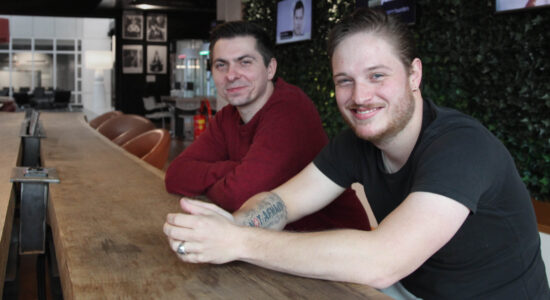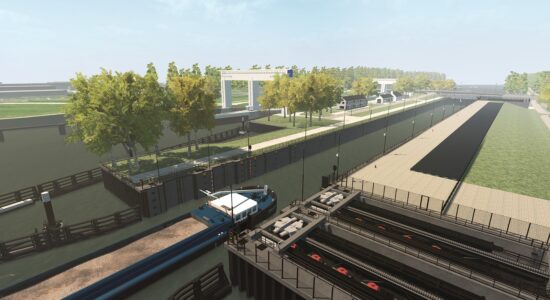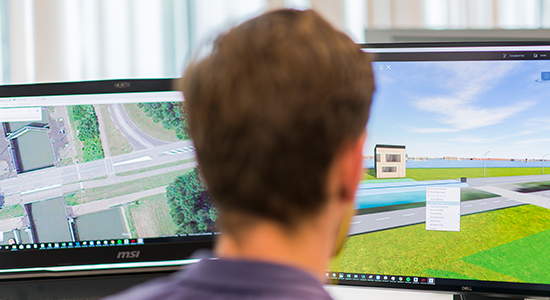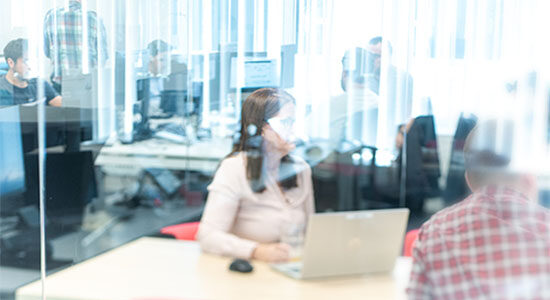What are the benefits of digital twins in infrastructure projects?
We asked Kevin Derksen and Daniel Purwin, digital engineers at Infranea, why they are passionate about digital twins and how they apply their knowledge in their work. They are convinced that digital twins play an important role in the digital transformation of the infrastructure sector. We find out why!
Where does this passion for digital twins stem from?
“My background is in the gaming sector”, explains Kevin. Designing digital twins has a lot of similarities with developing a game, it turns out. “We use the same software and techniques”, he explains, “and the user experience is also very central”. Daniel explains that he has always been interested in engineering and 3D visualisations. “With digital twins, I can combine my two passions,” he explains. Both Kevin and Daniel love to push boundaries, innovate and collaborate with different disciplines. “Digital twins have been around for a while in housing construction, for example, but at Infranea we work on a much larger scale,” Daniel adds.
What is a digital twin?
Kevin explains that Infranea develops digital variants of physical objects or artworks. For example, for the Prinses Beatrix lock in Nieuwegein or the A16 motorway for the De Groene Boog project in Rotterdam. For the latter project, commissioned by the De Groene Boog consortium and in cooperation with Soltegro, Infranea is first building an identical motorway (TWIN-16) in the virtual world, so that it can detect any unnecessary errors in advance, and better adapt everything to the environment. Infranea has already made a digital twin for the Prinses Beatrix lock, tested software virtually, trained lock operators and linked sensor data to simulate closing and opening hours, for instance. “A digital twin is therefore a virtual replica that is identical to the real thing, which sometimes still needs to be built”, Kevin explains.

Daniel Purwin and Kevin Derksen
At what stage of a project do you get involved?
Infranea goes a step further, by getting on board at a much earlier stage than usual. Because Infranea’s digital engineers design new infrastructure and objects in 3D, in practice they are also already making digital twins even before the actual object is created. “Creating a digital twin at a very early stage offers many more possibilities,” says Kevin.
What are the benefits of digital twins?
For example, if you wanted to build a tunnel in the past, you started with a design, then the construction phase was started and finally the test phase. Because of this final test phase, a fully completed tunnel will remain closed for several weeks. Sometimes even longer, if the tests show that adaptations or repairs are still necessary. That wastes time, and repairs at that stage cost a lot of money. The sooner errors are identified, the easier and more cheaply they can be resolved. With a digital twin of the design, it is possible to do a large part of these tests digitally, i.e. as early as the design phase. “We are currently carrying out a lot of virtual testing to test the dynamic behaviour of the technical installations during design,” explains Daniel, “including CCTV cameras, ventilators, matrix boards, lighting, emergency station cabinets, etc.”.
“I think that digital twins, just like BIM right now, will soon become a standard requirement for large projects as well.”
Kevin Derksen
What is the advantage compared to BIM or 3D?
According to Kevin, the added value of a digital twin over a BIM or 3D model is primarily the ability to incorporate interaction and dynamic behaviour. “Because we work in gaming software, there are hardly any restrictions there. Whereas with BIM you are limited by the functionalities of the software used, with a digital twin you build your own functionalities: barriers that are raised and lowered, controlling ventilators, opening and unloading the emergency station cabinets, producing realistic sound, adding traffic, etc.”. Infranea’s digital twin gurus get really excited when they tell us how other programmes or datasets can be linked to the digital twins. The possibilities turn out to be practically endless: operating technical installations in a virtual tunnel via the control programmes, simulating traffic on a motorway, performing fire and smoke simulations in a tunnel, simulating the operation of lock gates, etc.

Image from the VR Environment Twin 16 (A16 Netherlands)
How far can the ambitions of digital twins go?
For Kevin, the goal is the ‘first-time-right’ principle. That means being able to test practically everything in advance with digital twins. Only one test round is required after construction – in which everything works as it should. “Of course, it’s always a bit nerve-wracking, but in theory that’s where we want to aim for,” says Kevin. “Digital twins also have the advantage that you can carry out unlimited testing, whereas in the real world this would cost a lot of time and money”. Via the Centre for Underground Construction (COB in Dutch), Infranea is part of an expert team which verifies and validates in advance how safe tunnels function, using digital tools such as digital twins.
Can the emergency services also use digital twins?
“Yes, thanks to digital twins, it is now also possible to practice, train and instruct before construction, without closing the road, tunnel or bridge”, says Kevin. “Firefighters, police officers, ambulance crews, road traffic controllers, etc., can then experience how the object operates in certain disaster situations, using VR. For example, all emergency services can simulate a disaster and test the communication between them and the road traffic controllers, for example. The road traffic controllers can also train themselves in camera control, in advance. As such, all parties working in and around an object appear to benefit from digital twins in their own way.
Are there any benefits during maintenance after delivery?
“Another advantage is also its use for maintenance”, Daniel explains. “You do then need an exact copy of all underground and non-visible elements, such as cabling, foundation piles or pipes.” The idea is that maintenance staff can look up where all these elements are in the model and take them into account when they have to make adjustments. “You can also extract data from the digital twins, which you can then analyse in order to optimise the design. For example, placing road signs can be improved by eye tracking users driving through the model. Or for the person who has to set up the camera plan, we have developed a keyboard tool with which you can set up, install or replace cameras. With this tool, the person can actually set up the entire camera plan,” says Daniel.
Can the end user benefit from digital twins?
“Yes, for the general public, digital twins are ideal for communication in an innovation centre, where a new project is presented to the public”, Daniel explains. “For example, local residents who will use a road or tunnel in the future, or the patients and medical staff of a new hospital building. That way, everyone knows how it will look later on. Technical people can read the plans, but this is trickier for people who don’t have any experience. For example, they can then walk or drive through the design, from the driver’s perspective, and thereby see and experience everything.”
What are the challenges of digital twins?
For Daniel, the biggest challenge is that some project staff do not yet know exactly what digital twins are and what they can achieve with them. “As a result, we don’t always get the right information, or get it too late, because they don’t have insight into what information we need.” For Daniel’s work, the current challenge is to already build the digital twins while the design is not yet completely finished. As such, he gets updates on a regular basis. In the future, these updates could be fully automated, but that is not yet possible. “We do try to develop tools to automate sub-tasks as much as possible.” For Kevin, the biggest challenge has turned out to be linking the operating system to the digital twin. “That is slightly more complicated than what we normally do.”

Digital Twin Prinses Beatrix lock – Lock doors and signals linked to sensor data from the lock via the CMS
What is the future for digital twins?
For Daniel, digital twins are the logical next step in the evolution of digital engineering. “We started in 2D, then moved to 3D and the digital twins add an extra layer by linking with data from various sources and allowing us to really interact with the model. Kevin is convinced that digital twins will soon be linked to sensor data and internet of things networks. “Sensors can be installed in the built objects or installations to send information to the digital twin. This in turn displays the information in the model. For example, a barrier that is raised or lowered. In this way, the digital twin could be the central point within a project, where all the information comes together, and can be displayed and used.” A first step in this direction was our link between the digital twin of the Prinses Beatrix lock and the Condition Measurement System (CMS) that is used to monitor objects in the lock. Using sensor data, the position of the doors, the position of the levelling valves and the signal lights are monitored and shown ‘live’ in the Digital Twin. It is also possible to view and analyse historical data, which can be useful in the context of legal questions in the event of, e.g., disasters. Kevin is also convinced that the exchange of models between the BIM programmes and the digital twin will be much smoother in the future, thanks to automation and increased computing power. “I think that digital twins, just like BIM right now, will soon become a standard requirement for large projects as well.
Interested in working on innovative projects at Infranea?
Infranea is always looking for civil engineers with a passion for new technology and software that can be applied in the infrastructure and construction sector. At Infranea, you have the opportunity to play a leading role in the digital transformation of the infrastructure and construction sector in the Netherlands and Belgium.
More info on our job page.
25/11/2019



